Key takeaways:
- Minimalist landscapes evoke deep emotions through simplicity, encouraging reflection and appreciation of nature’s subtle details.
- Capturing minimalist photos requires techniques such as careful composition, using negative space, and understanding lighting to enhance the subject.
- The right equipment, like a lightweight tripod, versatile lenses, and filters, significantly improves the quality of minimalist photography.
- Patience and trust in one’s instincts are vital, allowing photographers to discover beauty in simplicity and unassuming subjects.
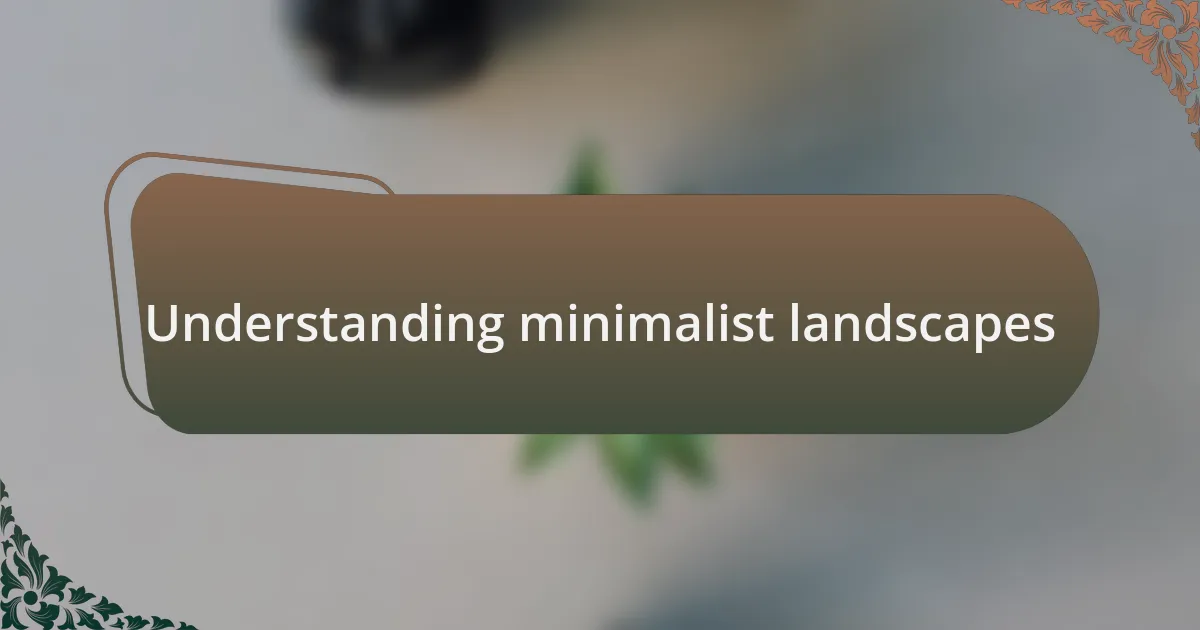
Understanding minimalist landscapes
When I first encountered minimalist landscapes, I was struck by their ability to evoke deep emotions through simplicity. The absence of clutter in such scenes often encourages me to reflect on the essence of nature, leading me to ponder why we tend to overlook the beauty in less. Does the space around a solitary tree or a vast expanse of sky not compel us to find peace in our thoughts?
I remember standing at the edge of a serene lake, the only elements being the still waters and distant mountains. It made me realize that minimalist landscapes invite us to embrace silence and solitude, revealing layers of meaning often drowned out by a busy world. Each photograph becomes a meditation, a moment captured in time that inspires us to appreciate the subtle details.
Moreover, the use of negative space in these compositions is fascinating. It draws our eyes and hearts toward the central subject, creating a conversation between the object and its surroundings. Have you ever noticed how that empty space can feel like an invitation, encouraging you to step into the frame and connect?
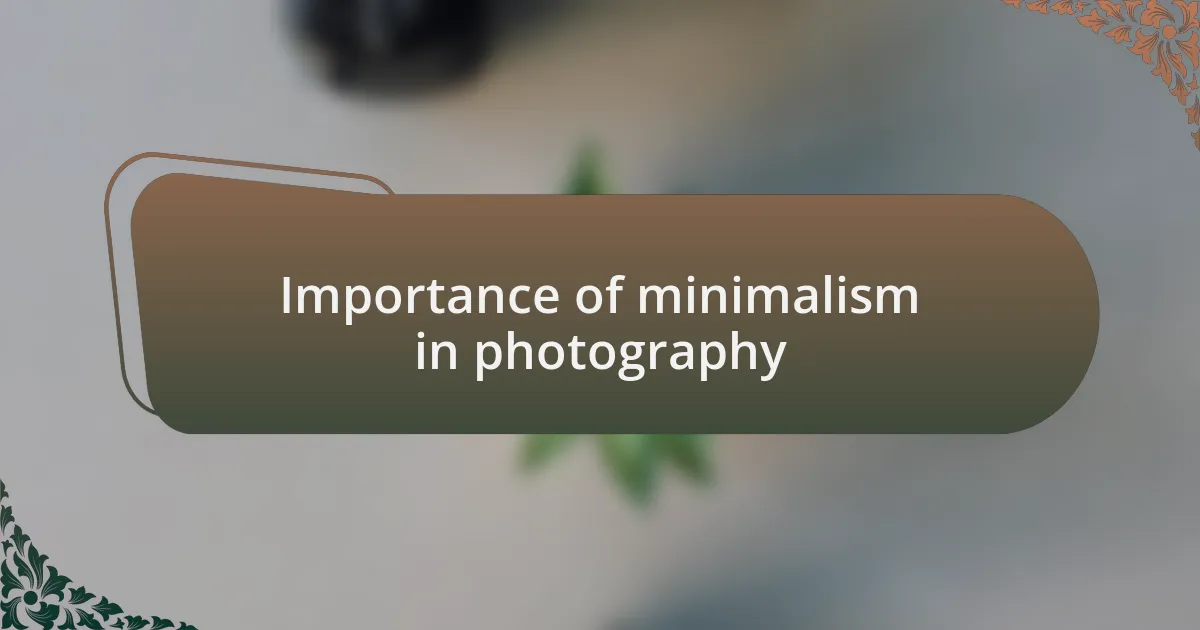
Importance of minimalism in photography
Minimalism in photography is immensely important because it allows the viewer to focus on the essence of the subject matter without distractions. I recall a time when I captured an image of a lone rock on a sandy beach at sunset. The vastness of the empty shoreline made the rock feel monumental, emphasizing its beauty in isolation. This experience taught me that sometimes, less really is more, as the simplicity leads to stronger emotional connections.
The beauty of minimalism lies in its ability to convey a narrative through very few elements. I often find that striking images with just a hint of detail can evoke more profound feelings than a crowded scene. For instance, a photo of a single flower against a blurred background can evoke feelings of vulnerability and resilience. Does this not remind us that each small element in nature has its significance, and that importance can shine brightly when it stands alone?
Furthermore, embracing minimalism challenges us as photographers to think creatively and find beauty in unconventional compositions. I distinctly remember experimenting with a barren tree against a cloudy sky. Initially, it seemed simplistic, but as I worked with the light and angles, I unearthed a captivating contrast that spoke volumes. Have you ever felt that thrill of discovering unexpected layers in a seemingly simple shot? Engaging with minimalism pushes our skills and perception, ultimately enhancing our artistic vision.
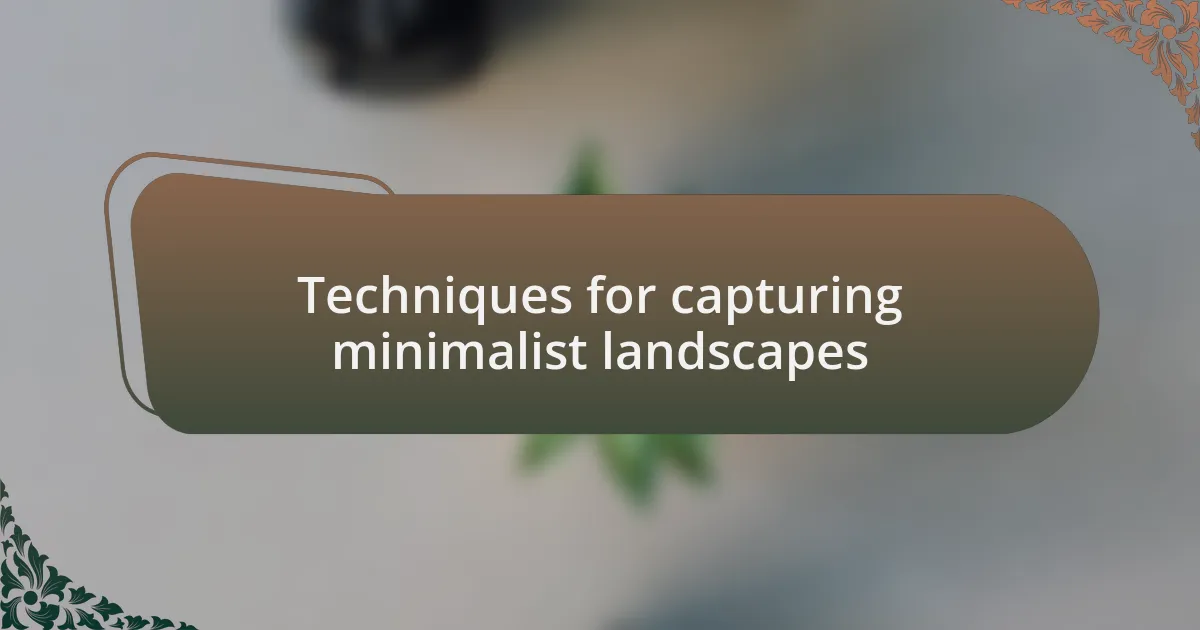
Techniques for capturing minimalist landscapes
Finding the right composition is fundamental when capturing minimalist landscapes. I remember a day when I ventured into a misty forest, where the fog enveloped the trees, allowing their silhouettes to emerge softly. By carefully framing a single tree against that ethereal backdrop, I created a composition that drew the viewer’s eye and sparked a sense of serenity. Isn’t it fascinating how just one element can transform a scene into something so serene and powerful?
Playing with negative space is another technique that can elevate minimalist photography. I once aimed my lens at an expansive desert scene, where the dunes stretched endlessly. By leaving a significant portion of the frame empty, I highlighted the undulating curves, creating an abstract visual that felt both haunting and beautiful. How do you feel when you see a vast, empty space? It can evoke profound emotions, encouraging a sense of peace or longing.
Lighting also plays a crucial role in minimalism. I recall capturing a striking image at dawn, where soft, golden light illuminated a solitary rock formation. The warm hues and gentle shadows emphasized its textures while maintaining simplicity. It’s amazing how light transforms a scene. Do you ever stop to think about how various times of day can alter your perception of a subject? It’s in these subtle shifts that the magic of minimalist photography truly reveals itself.
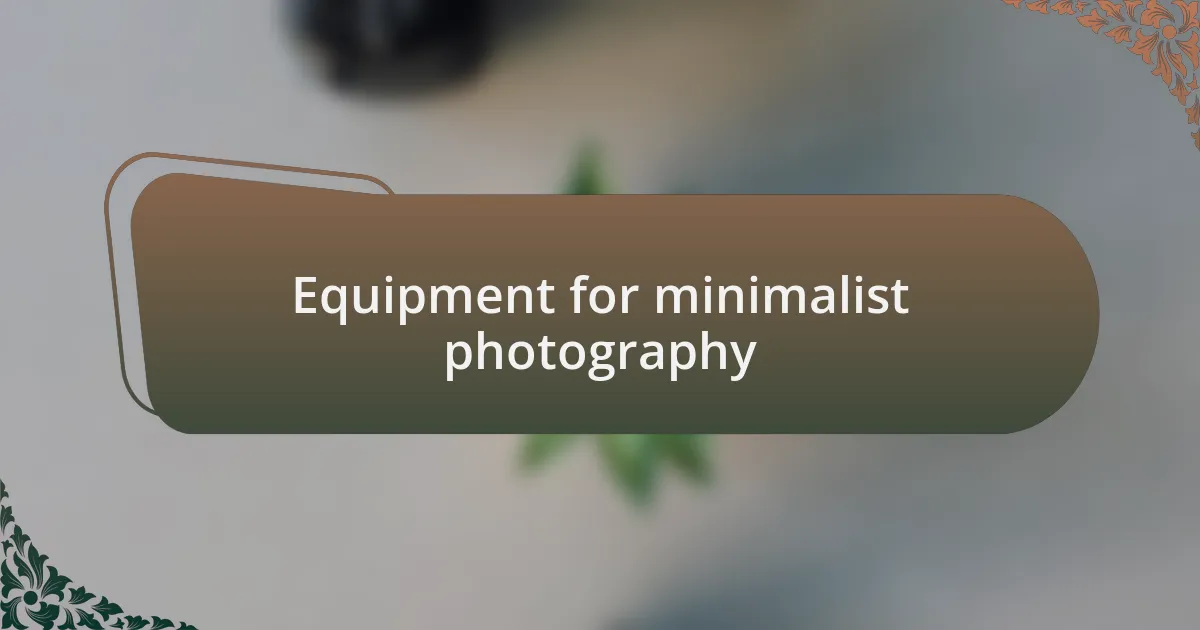
Equipment for minimalist photography
When it comes to minimalist photography, the right equipment can make all the difference. I often rely on a lightweight tripod for stability, especially in low-light situations. I remember one evening, setting up my camera in a quiet lakeside setting as the sun dipped below the horizon. With a sturdy tripod, I was able to capture the smooth water and the delicate colors reflecting on its surface without any blur. Isn’t it amazing how such a simple tool can elevate the quality of your work?
A versatile lens is another essential for minimalist landscapes. I typically use a wide-angle lens, which allows me to encompass vast spaces while keeping the focus sharp on my chosen subject. There was a time I found myself standing on a cliff, overlooking a vast expanse of rolling hills. Using that wide-angle lens, I drew attention to a solitary tree on the horizon, seamlessly blending it with the landscape. Have you ever noticed how a change in perspective can redefine your entire composition?
Lastly, I can’t stress enough the importance of filters, particularly polarizers. They help enhance colors and reduce glare, which is crucial when photographing elements like water or foliage. During a recent shoot in a sun-drenched field, I attached a polarizing filter to my lens, and the colors instantly popped. The grass seemed greener, and the sky bluer. Have you experienced that kind of transformation in your own images? Filters can truly turn an ordinary shot into something remarkable.
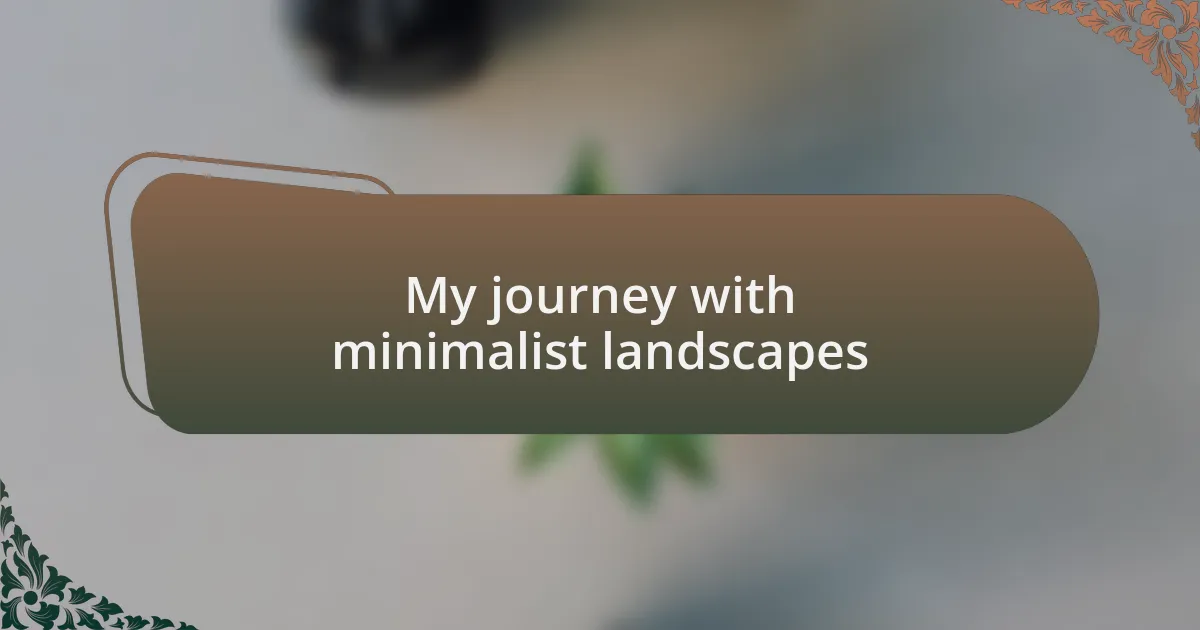
My journey with minimalist landscapes
My journey with minimalist landscapes has often led me to embrace simplicity in my compositions. I recall one particular morning in a deserted desert, where the vastness of space felt almost overwhelming. As I focused on a single, weathered rock against the endless sand, I realized that less truly could be more, allowing the viewer’s imagination to wander without distraction. Have you ever stood before an empty landscape and felt its vast stories speak to you?
Embracing the ethos of minimalism changed how I approach my subjects. During a rainy afternoon, I ventured to a quiet beach, where the clouds hung heavy above, casting a muted light. I spotted a lone seagull perched on a post, seemingly lost in thought. Capturing that moment reminded me that minimalism isn’t just about what you leave out; it’s also about highlighting the beauty in solitude. Doesn’t capturing a fleeting moment make you appreciate the stillness even more?
Exploring minimalist landscapes has transformed my perspective on what constitutes beauty. One vivid memory stands out: photographing frost-kissed branches in the early light of dawn. Each branch, dusted with a delicate layer of frost, became a detailed subject, rich with textures and contrasts. It’s in these subtle scenes that I find inspiration, encouraging me to appreciate imperfections. Have you found beauty in simplicity during your own photography adventures?

Lessons learned from my experience
The experience of photographing minimalist landscapes has taught me that patience is key. I remember standing in a foggy forest, waiting for the mist to envelop a solitary tree. That stillness, as time seemed to stretch, revealed a hidden beauty I might have missed if I rushed to capture the shot. Have you ever felt the weight of anticipation transform your vision?
Through this journey, I’ve learned to trust my instincts more than I ever thought possible. Once, while exploring a quiet shore, I was drawn to a simple patch of sand with intricate footprints etched into it. Choosing to focus on that small detail taught me that powerful stories can emerge from the most unassuming subjects. Isn’t it fascinating how a tiny slice of scenery can evoke such profound emotions?
Minimalism has also prompted me to refine my technical skills. I’ve discovered that subtle adjustments in framing can dramatically alter a composition’s impact. During one shoot in an urban setting, I played with negative space by isolating a single flower against a bustling backdrop. This meticulous approach revealed how powerful simplicity can be in conveying a message. Do you ever find that the smallest details can elevate an entire image?

Showcasing my favorite shots
There’s a certain serenity in my favorite shots that truly captures the essence of minimalist landscapes. One image I cherish showcases a lone boulder resting atop a vast, empty shore. The contrast between the solid rock and the endless ocean echoes a sense of solitude that resonates deeply with me. Have you ever found yourself lost in a moment that seemed both quiet and powerful at the same time?
One of my standout moments came when I captured a single leaf floating on a tranquil pond. The reflections danced around it, creating an almost meditative scene that drew me in. Looking at it now, I remember the calm that enveloped me during that shoot. It makes me wonder: how often do we take a moment to appreciate the simplicity in nature that tells such rich stories?
A shot that continues to inspire me is that of a sprawling field under a vast sky, where the horizon stretched endlessly. It represents freedom for me, that feeling of possibility that comes with wide-open spaces. I often ask myself, what does freedom look like to you? For me, it’s encapsulated in that serene expanse, a reminder to always seek the beauty in simplicity.